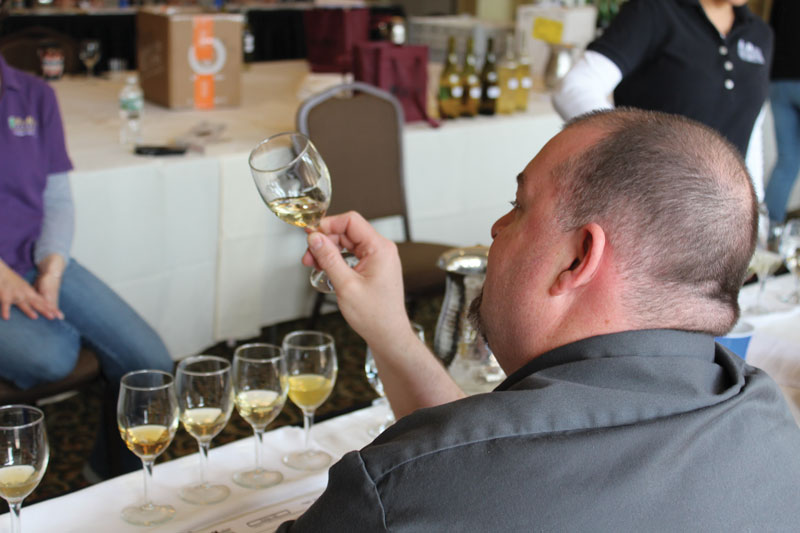Don’t worry, it’s happened to the best of us! If you can, check your pH and your VA (volatile acidity) to try to get a handle on whether or not this air intrusion caused any chemistry-altering damage to the wine. What I mean is, sometimes when we have an oxygen incursion it can mean an increase in spoilage bacteria that can lead to high VAs, film yeasts, and other issues. For this reason, if you have the capability, I’d sterile filter this wine immediately to rule out the possibility of a high count of spoilage organisms in the wine. That being done, you can focus on some of the following approaches to try to “recover” the wine and nudge it back to where it was heading before it got a big oxygen shock.

Get it topped, adjust pH (if needed), and add SO2: If you can filter your wine, do it as soon as you can to remove the possibility of microbial damage. Then, adjust the free SO2 up to a healthy zone, which for a filtered red wine like Cabernet can often be 25–35 ppm, as long as your pH is under control. What I mean by under control is subjective. I’ve given up chasing the holy grail “molecular SO2” of 0.8 ppm. Molecular SO2 is a measurement based on both the pH and free SO2 of a wine, and to achieve 0.8 ppm, more often than not your pH has to be very low, your SO2 level very high, or both. Because of style and taste (hey, we want our wines to taste good, right?), getting any wine, especially a red wine, to conform to those parameters is just not realistic. For that reason, I choose to have my pHs for reds rest between 3.5–3.75 and my free SO2 between 25–35 ppm. I’ve found over the years that that’s a pretty good sweet spot for me, as long as I’m topping barrels monthly and monitoring my oxygen ingress as well as VA levels.
Blend out the defect: Don’t forget that blending is always an option . . . as long as you have other wines. Do your winemaking buddies have some gallons they could lend you this year in exchange for replacement in a future year? In a pinch, and only with full disclosure to your friends (no bragging rights on bought wine!), I do think it’s OK to purchase a bottle or two off of the shelf to be able to blend something down. However, this probably won’t work with a 60-gallon (227-L) lot — that’s a lot of wine you’d have to buy! However, it’s likely that you’ve got other avenues, so read on below.
Sometimes all a wine needs, especially a red like a Cabernet, is a little bit of oak.
Try an oxidation-specific fining agent: Most winemaking supply companies (AEB, Laffort, Scott Labs, etc.) will have a fining agent that specifically targets oxidized aromas and flavors. Often, they contain PVPP, and may strip color, so do be sure you do bench trials first. Have a chat with a sales representative or check out their websites and it’s likely you’ll find something that could help.
Try refreshing with oak chips: Sometimes all a wine needs, especially a red like a Cabernet, is a little bit of oak. If your wine got a big hit of oxygen, I’m guessing it lost some of its fruit character. There are a number of oak chips on the market that can help contribute not exactly fruity flavors, but elements like spice, coffee, or vanilla. These chips don’t actually have spice, coffee, or vanilla in them — they are just specifically sourced and toasted to express those characteristics in wine. For a barrel or even a carboy, you can easily make a little chip “sock” by putting small chips into a mesh or nylon bag. A nylon stocking makes a perfect single-use bag. To punch up some new aromas and add back some of the antioxidants you lost (also, see “Try a fining tannin”, below) experiment with about 1–2 g/L chip addition and see where that takes you. As always, be sure to buy chips from a reputable supplier with high turnover for freshness and best quality.
Try a fining tannin: As logic would have it, you’ve introduced oxygen, which has reacted with some of the natural antioxidants in your Cabernet (the color and tannin molecules). So it would make sense that now you have to build them back up again, right? Some of my favorite, and certainly the most versatile, winemaking aids I’ve discovered in the last five years are the new breed of oak and grape tannins available on the market. The aforementioned winemaking supply companies all carry different kinds of tannins that can be added during fermentation, aging, or even just before bottling, to boost body, grip, or even to give a subtle oak flavor. They are extracts from oak and grape skins, typically, so are just another way of introducing some of the elements you’d get from a barrel or from fermentation. They can also do wonders in reviving and refreshing a wine that is getting tired from age or suffered an untimely accident, like yours. Again, be sure to do bench trials so you see what works and at what levels. All suppliers should be willing to give you a tiny packet or vial with which to do trials before making a purchase, and likewise should be able to guide you towards which of their products they think would work the best. Good luck — I have faith that your wine is not beyond rescue.




